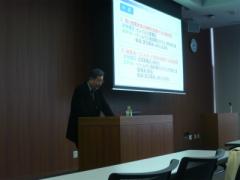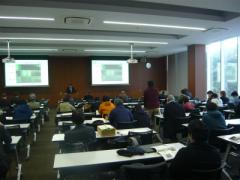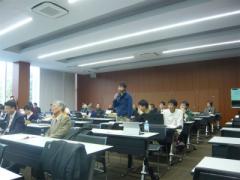
電気絶縁技術の最前線(2015/3/9 九州工業大学)
2015/03/31
【科目種別】電気エネルギー講座Ⅰ(日本語科目)
※日本語講義3件受講・報告書提出で1講義(2コマ)分
電気エネルギー講座Ⅱ(英語科目)
※17時~の講義受講後、18時~ディスカッションに
参加・報告書提出で1講義(2コマ)分
■日 時:2015年3月9日(月)15:00 ~19:00
■場 所:九州工業大学 百周年中村記念館 多目的ホール
■主 催: 国立大学法人 九州工業大学大学院 工学府電気電子工学専攻
■学生の関わり様
液体・固体中の電気絶縁現象の最新動向に関して、講義はわかりやすく基礎から始まり、応用と最新成果が紹介された。各講演後に学生からたくさんの質問が積極的に出た。聴講者は約50名と多かったが、学生は臆することなく積極的に質問していた。講演内容が学生の研究内容に近いこともあり、放電現象メカニズムや実器対応や計測技術などに対する具体的な質問がなされた。講演会後も各講師に対して学生から積極的に個別質問する様子が見られた。
■タイムテーブル
15:00~15:40
演題:『植物由来絶縁油と鉱油中の沿面放電現象』
講師:花岡 良一 教授 (学校法人 金沢工業大学)
15:40~16:20
演題:『エステル系絶縁油と鉱油のブレンドにおける電気的特性』
講師:宮城 克徳 教授 (学校法人 金沢工業大学)
16:20~16:30 休憩
16:30~17:10
演題:『電力機器の部分放電劣化診断』
講師:岡本 達希 氏 (一般財団法人 電力中央研究所)
17:10~18:00
演題:“Partial Discharges in Aeronautics: The last frontier ?”
講師:Thierry Lebey 教授 (ポールサバティエ大学)
※18:00より1時間程、ディスカッション
■概 要
<花岡教授>
題目: 植物由来絶縁油と鉱油中の沿面放電現象
概要:菜種油、PFAE油、鉱油中のインパルス沿面放電と交流 沿面放電の特性について、最近の研究結果を紹介する。
<宮城教授>
題目: エステル系絶縁油と鉱油のブレンドにおける電気的特性
概要:植物由来のエステル系絶縁油と鉱油のブレンドが電気絶縁特性に及ぼす影響について,絶縁破壊電圧(交流),および?発光ストリーマの観測(パルス)を比較した初歩の 調査結果について紹介する。
<岡本氏>
題目: 電力機器の部分放電劣化診断
概要: 昭和51年電力中央研究所に入所依頼、現在に至るも部分放電計測の研究を続け、既に約40年の長きに渡る経験を積んで来た。その間、各種の電力機器の欠陥を模擬した
部分放電モデルにおける部分放電特性の測定、実機での部分放電測定、さらには部分
放電モデルにおける部分放電特性の理論的な検討などを実施してきた。今回はこれら
全てを含めて、部分放電関連研究の紹介をする。
<レベイ教授>
題目: Partial Discharges in Aeronautics: The last frontier ?
概要: The increasing development of aerial mass transportation associated to the problems related to sustainability at the dawn of this new millennium, have driven the main airplane manufacturers to change their paradigms. In a first step, a particular attention has been drawn to the non-propulsive power systems. The main idea is to replace the combination of hydraulic, pneumatic, electrical and mechanical power by a More (and “All” in the future) Electrical Airplane approach consisting in an increasing use of power electronics and electric power conversion. The conversion chain is mainly constituted by Power Electronics converters whose technology has made tremendous breakthroughs over the past decade and actuation such as electromechanical actuators (EMA), electro-hydrostatic actuators (EHA), fault-tolerant electric motor/generators,…
In parallel, the increasing demand for more on board power (up to and sometimes higher than 1 MW) on the long-haul airplanes has led to increase the voltage and/or to change its shape (from AC to DC). In a second step, some advanced studies imagine that even the propulsion may be electrical in the future thus leading to a real high voltage ( >1 kV)
Such an increase may lead, depending on many parameters related to the electrical characteristics of the chain (power converter, voltage waveform (dV/dt, frequency,…), the cables length, the type of machine driven) or to the aeronautic environment (pressure, temperature, relative humidity) to the ignition of Partial Discharges in systems which were not supposed (and have not been designed) to endure them.
One of the main questions to address is the development of an approach for PD detection allowing the determination of their existence under very different electrical conditions (AC, DC, PWM) due to the wide nature of the embarked equipments and to the different possible natures of the discharges.
The recent advances made in the related different topics i.e on line PD detection under PWM voltage, influence of the pressure, influence of the components types…will be presented and discussed regarding their consequences.
※日本語講義3件受講・報告書提出で1講義(2コマ)分
電気エネルギー講座Ⅱ(英語科目)
※17時~の講義受講後、18時~ディスカッションに
参加・報告書提出で1講義(2コマ)分
■テーマ『電気絶縁技術の最前線』
■日 時:2015年3月9日(月)15:00 ~19:00
■場 所:九州工業大学 百周年中村記念館 多目的ホール
■主 催: 国立大学法人 九州工業大学大学院 工学府電気電子工学専攻
■学生の関わり様
液体・固体中の電気絶縁現象の最新動向に関して、講義はわかりやすく基礎から始まり、応用と最新成果が紹介された。各講演後に学生からたくさんの質問が積極的に出た。聴講者は約50名と多かったが、学生は臆することなく積極的に質問していた。講演内容が学生の研究内容に近いこともあり、放電現象メカニズムや実器対応や計測技術などに対する具体的な質問がなされた。講演会後も各講師に対して学生から積極的に個別質問する様子が見られた。
■タイムテーブル
15:00~15:40
演題:『植物由来絶縁油と鉱油中の沿面放電現象』
講師:花岡 良一 教授 (学校法人 金沢工業大学)
15:40~16:20
演題:『エステル系絶縁油と鉱油のブレンドにおける電気的特性』
講師:宮城 克徳 教授 (学校法人 金沢工業大学)
16:20~16:30 休憩
16:30~17:10
演題:『電力機器の部分放電劣化診断』
講師:岡本 達希 氏 (一般財団法人 電力中央研究所)
17:10~18:00
演題:“Partial Discharges in Aeronautics: The last frontier ?”
講師:Thierry Lebey 教授 (ポールサバティエ大学)
※18:00より1時間程、ディスカッション
■概 要
<花岡教授>
題目: 植物由来絶縁油と鉱油中の沿面放電現象
概要:菜種油、PFAE油、鉱油中のインパルス沿面放電と交流 沿面放電の特性について、最近の研究結果を紹介する。
<宮城教授>
題目: エステル系絶縁油と鉱油のブレンドにおける電気的特性
概要:植物由来のエステル系絶縁油と鉱油のブレンドが電気絶縁特性に及ぼす影響について,絶縁破壊電圧(交流),および?発光ストリーマの観測(パルス)を比較した初歩の 調査結果について紹介する。
<岡本氏>
題目: 電力機器の部分放電劣化診断
概要: 昭和51年電力中央研究所に入所依頼、現在に至るも部分放電計測の研究を続け、既に約40年の長きに渡る経験を積んで来た。その間、各種の電力機器の欠陥を模擬した
部分放電モデルにおける部分放電特性の測定、実機での部分放電測定、さらには部分
放電モデルにおける部分放電特性の理論的な検討などを実施してきた。今回はこれら
全てを含めて、部分放電関連研究の紹介をする。
<レベイ教授>
題目: Partial Discharges in Aeronautics: The last frontier ?
概要: The increasing development of aerial mass transportation associated to the problems related to sustainability at the dawn of this new millennium, have driven the main airplane manufacturers to change their paradigms. In a first step, a particular attention has been drawn to the non-propulsive power systems. The main idea is to replace the combination of hydraulic, pneumatic, electrical and mechanical power by a More (and “All” in the future) Electrical Airplane approach consisting in an increasing use of power electronics and electric power conversion. The conversion chain is mainly constituted by Power Electronics converters whose technology has made tremendous breakthroughs over the past decade and actuation such as electromechanical actuators (EMA), electro-hydrostatic actuators (EHA), fault-tolerant electric motor/generators,…
In parallel, the increasing demand for more on board power (up to and sometimes higher than 1 MW) on the long-haul airplanes has led to increase the voltage and/or to change its shape (from AC to DC). In a second step, some advanced studies imagine that even the propulsion may be electrical in the future thus leading to a real high voltage ( >1 kV)
Such an increase may lead, depending on many parameters related to the electrical characteristics of the chain (power converter, voltage waveform (dV/dt, frequency,…), the cables length, the type of machine driven) or to the aeronautic environment (pressure, temperature, relative humidity) to the ignition of Partial Discharges in systems which were not supposed (and have not been designed) to endure them.
One of the main questions to address is the development of an approach for PD detection allowing the determination of their existence under very different electrical conditions (AC, DC, PWM) due to the wide nature of the embarked equipments and to the different possible natures of the discharges.
The recent advances made in the related different topics i.e on line PD detection under PWM voltage, influence of the pressure, influence of the components types…will be presented and discussed regarding their consequences.












